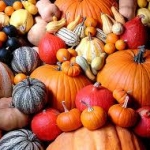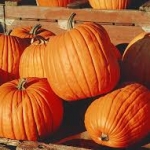Pumpkin Power!
 Halloween just wouldn’t be Halloween without pumpkins. Carved or uncarved, they make great decorations, and even better pies, stews, and soups. Pumpkins also have an interesting and unique history.
Halloween just wouldn’t be Halloween without pumpkins. Carved or uncarved, they make great decorations, and even better pies, stews, and soups. Pumpkins also have an interesting and unique history.
Pumpkins arrived on the scene between 7,000 and 5,550 BC in Mexico. These early varieties bore more resemblance to gourds or squash than the creased orange Jack-o-lanterns we’ve come to know and love. Their hard skin made them ideal for storing, a fact that was not lost on Native Americans. They were grown along river banks with sunflowers and beans; and, when corn cultivation began years later, in concert with squash and corn using the ‘Three Sisters’ method.
Whether roasted over campfires, baked, parched, boiled, or dried, pumpkins were prepared in a variety of ways. Their seeds were eaten and used as medicine. Dried pumpkin was sometimes used as a flour, and their shells used as bowls to store grain, beans, and seeds. Strips of dried pumpkin were sometimes even woven into mats!
Pilgrims are responsible for the first pumpkin pie, but not the flat-crusted variety we’re used to. After cutting off the top and scooping out the seeds, they would fill the cavity with cream, honey, eggs, and spices, and then, with top reattached, bury the entire pumpkin in the hot ashes of a fire.
 No one really knows just how pumpkin carving began, but there are theories. Early Jack-o-lanterns made from turnips and potatoes were used in Celtic celebrations; these contained pieces of lit coal. Europeans who arrived in America noticed that the pumpkin made a good Jack-o-lantern, and the tradition was born.
No one really knows just how pumpkin carving began, but there are theories. Early Jack-o-lanterns made from turnips and potatoes were used in Celtic celebrations; these contained pieces of lit coal. Europeans who arrived in America noticed that the pumpkin made a good Jack-o-lantern, and the tradition was born.
